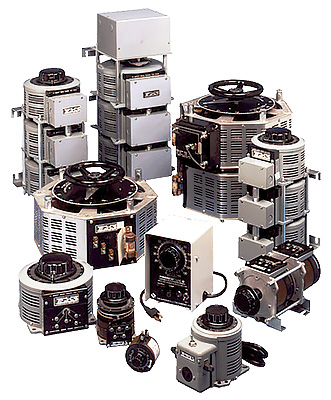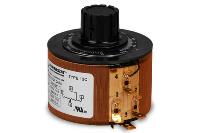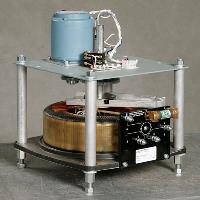Variable Transformers
What is a Variable Transformer?
Variable transformers provide a simple, rugged method of controlling electrical voltage, current and power. Utility line voltage is transformed into continuously adjustable output voltage. Incorrect AC line voltage is adjusted the turn of a dial. The same dial acts a rheostat to control the speed of motors; cutting input voltage reduces the motor speed. A turn of the dial converts power line output into the desired voltage.
Versatility of the variable transformer lies in its ability to tap in anywhere from 0 to 100% of the line voltage, plus another 17% usually available because of a few extra windings in the secondary. Depending on the frame size, the output current ranges from 1 to 50 A at 120 V or half this amperage at 240V. Added versatility is possible by larger size units. Some single coil variable transformers are available with output rates low as 0.13 kV A and "ganged" 3-phase variable transformer units can reach 15 kVA.
Most common use, especially with the smaller 500 to 750VA sizes, is to obtain AC voltages different from the normal 120 or 240 V, single or three-phase supply. The other major use is delivering either standard or test voltages from lines where voltages fluctuate above or below the normal standard.

Our Products
POWERSTAT® Variable Transformers
Rugged, and designed for heavy-duty use, POWERSTAT® Variable Transformers provide excellent power regulation with negligible variation in output voltage from no-load to full-load current. They provide a simple, rugged method of controlling electrical voltage, current and power. They take in utility line voltage and provide continuously adjustable output voltage. Available in both manual and motor-driven options, they offer high current ratings, long life, superior overload capacity and exception resistance to contaminants such as fungus and salt spray.
Volt-Pac® Variable Transformers
Variable Transformer Applications
- Voltage correction for under-voltage or over-voltage supplies on
1, 2 or 3-phase circuits - Producing variable DC voltages from AC sources, usually by control of input voltage to rectifier elements
- Heater or oven temperature control. Voltage adjustment in addition to usual thermostatic control provides more uniform heating
- Dimming or controlling incandescent lamp circuits. Life of lamps goes down significantly when operated above rated voltage. Conversely lamp life increases significantly when operated below rated voltage
- Varying step-transformer output voltage by control of input voltage
- Operating motors and other electrical equipment at correct voltages even when supply is above or below normal. Starting characteristics at subnormal voltages and heating at higher than normal voltages are critical design factors.
- Speed control of some AC motors and of DC motors operation rectified AC circuits. Fan and other motors with low starting torque are good applications.
- Providing voltages not commonly used for tests or operational runs
- Calibrating electrical equipment and controls
- Servo motor regulation
Commonly asked questions about variable transformers
How Does a Variable Transformer Work?
Variable transformers take in utility line voltage and provides continuously adjustable output voltage in the range of zero to or above line voltage. Once the equipment is connected, the voltage can be adjusted by rotating the brush tap.
What are the applications of a variable transformer?
The most common application of a variable transformer is to obtain AC voltages different from the normal 120 or 240 V, single or three-phase supply. It is also common to use variable transformers to test devices under different voltages or to simulate abnormal line voltages, controlling incandescent lamp circuits, and operating motors and other electrical equipment at various voltages.
What is the difference between variable transformers and variable autotransformers?
The difference between a variable transformer and an variable autotransformer is that the autotransformer does not have a dual-coil design. For the autotransformer, one coil is used as the primary and secondary.




